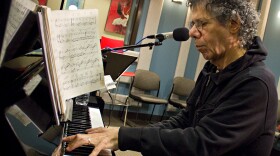This feature is derived from KNKX's Tree of Jazz, taking you through the eras, from the roots to the new budding leaves, with a weekly deep dive into iconic artists, albums, and instruments.
In 1957, two of jazz’s greatest iconoclasts, pianist Thelonious Monk and saxophonist John Coltrane, spent six months playing together at the Five Spot Café in New York City. The short-lived band marked a comeback era for both musicians. Although the sessions at Five Spot Café were never recorded, they were reportedly immensely popular, and two full albums from Monk— whose birthday is Oct. 10 —offer a glimpse into what those sessions may have been like.
“Working with Monk brought me close to a musical architect of the highest order. I felt I learned from him in every way; through the senses, theoretically, technically,” Coltrane wrote for Downbeat Magazine in 1960.
For Monk, the Five Spot Café gig was his return to the stage after a six-year forced hiatus from playing New York City clubs. In 1951, Monk took a possession charge after he and fellow pianist and friend Bud Powell were stopped with drugs on them.
Monk reportedly took full responsibility so that Powell would avoid jail time, and the charge led to Monk’s cabaret card being revoked. A cabaret card was a musician's license to play music in venues that served alcohol. The cabaret card system would eventually be abolished in 1967, and after six years and pressure from his colleagues, Monk's card was reinstated and he was able to play the residency at the Five Spot.
Coltrane, too, had personal struggles before the residency with Monk. Coltrane had his first stint with Miles Davis’ band from 1955 until mid-1957. Coltrane was kicked out for his unprofessional demeanor, which stemmed from his substance addiction at the time. After cleaning up in his hometown of Philadelphia, he returned to NYC to join Monk at the Five Spot.
The two giants of jazz took to the Five Spot’s low stage, where the walls were plastered with event and art posters, and no more than a hundred people could fit comfortably. The band was rounded out with Wilbur Ware on bass and Shadow Wilson on drums. According to JazzTimes, Trombonist J.J. Johnson recalled hearing Coltrane with Monk at the Five Spot as “the most electrifying sound” he’d heard since Charlie Parker, “incredible, like Diz and Bird.”
While there are no quality recordings of the two playing together at the Five Spot Café, there is evidence of what the Monk-Coltrane band could have sounded like at the time.
One example was a studio session in June of 1957 that would become the album Monk’s Music, with its playful cover art. Coltrane, Coleman Hawkins, and Art Blakey join Monk on an extended version of “Well You Needn’t.” After taking the lead solo, Monk yells out, “Coltrane! Coltrane!” before Coltrane leaps into a roaring solo.
Many years later, a grand chapter was added to the story of Monk and Coltrane. After being “lost” for many years, a high-fidelity recording of the band at Carnegie Hall was found in the Library of Congress. The album Monk, Coltrane at Carnegie Hall was originally recorded for a Voice of America broadcast. In 2005, the 1957 recordings were released by Blue Note and became a celebrated time capsule of the short-lived collaboration.
Coltrane would eventually leave the residency and rejoin Miles Davis' band. Monk continued the Five Spot residency, recruiting another legendary saxophonist, Johnny Griffin to join the band. With Griffin, Monk recorded two albums at the club in 1958: Thelonious in Action and Misterioso.
Following the residencies, Monk’s off-kilter piano and daring harmonics became more accepted in mainstream jazz. Coltrane continued to push his “sheets of sound” technique further in the 1960s.
The broad strokes of history might not pin their stories together; they both had more high-profile and better-documented gigs. But we can look back at their time on the bandstand together and see their aligned desire to push creativity. And, the relative mystery of what it was like in that small club with the two giants of jazz can continue to excite our imaginations.
This story comes from the October 12, 2025, episode of the Tree of Jazz. Listen to the past two weeks of Tree of Jazz On-Demand, and hear deep dives like this each week on air and online every Sunday from 3-6 p.m. PT.








